16. Reinvigorating Your Six Sigma Program
With Debby Sollenberger
Why in the world, you might ask, would you write a book on deploying Six Sigma in 90 days and end the book with a chapter about reinvigoration? Every company that has deployed Six Sigma has always set forth some actions to keep the program in tune to the company.
Any change initiative becomes different as the company learns the initiative and what it can do. For example, moving Six Sigma to parts of the company that were not initially heavily involved usually reinvigorates Six Sigma. An example of that would be a company that initially focuses on manufacturing improvement and then moves Six Sigma into product design and sales and marketing.
Also, the business reality for a company is not stagnant. As the business reality changes, Six Sigma must be modified to meet the new gaps in the market. I will be addressing three topics in this chapter:
• Critically analyzing your deployment.
• Back to the basics.
• Time to extend Six Sigma.
All of these topics apply to a new deployment as well as a deployment that is a year or two old. Going in to the first 90 days of a deployment is a good time to see potential failure modes and deployment opportunities. Potential reinvigoration targets are gaps in executing your strategy or business model. If you recall, Larry Bossidy’s business model from his book, Confronting Reality, includes linking your external realities, financial targets, and internal activities. Here’s how you can use those three components to look for reinvigorating opportunities:
• External Realities
• Have you identified gaps in customer satisfaction?
• Are there new markets to attack?
• Financial Targets
• Is it time to set new financial targets or operating metrics?
• Financial: operating margins, cash flow, revenue growth, ROE.
• Operating metrics: productivity, quality, cost of poor quality.
• Internal Activities
• Is your strategy linked to the annual operating plan?
• Are your Six Sigma projects linked to the strategy and annual operating plan?
There are several reasons to always think about reinvigorating Six Sigma. Any change initiative has a risk of failure. Bossidy even said that if Six Sigma wasn’t successful within AlliedSignal, he would never be able to successfully launch another change initiative. Because Six Sigma is complex, it is impossible to forecast all failure modes in advance and prevent them. The purpose of this book is to minimize the number of events that can go wrong. To make change work requires constant vigilance and correct innovation and action. By making sure Six Sigma works, you’ll be known as a
• Company that executes.
• Company that deploys and achieves action.
• Company that has a core competency of deploying initiatives.
• Company that leverages human creativity and potential.
In addition, the final impacts of a successful Six Sigma program are the factors every company would like in place.
• Every employee understands the company’s business, goals, and vision.
• Every employee knows how he or she contributes to the company.
• Every employee knows how to improve processes.
• Every employee knows how to solve problems.
• Every function works together seamlessly.
To assess your Six Sigma deployment, you can use Larry’s advice on leading a change initiative:
• Learn the guts of it.
• Invest your time and energy.
• Pick the right people to initiate it.
• Be courageous.
The quality of deployment excellence is directly linked to how you and your fellow leaders accomplish the preceding. Change is not easy, but it is a lot of fun when it works.
Critical Analysis of Your Six Sigma Deployment
The first step in reinvigorating Six Sigma is to do a program assessment. In this assessment, you must consider the following deployment factors:
• The Power of Assessment: Analyze
• Leadership and accountability
• Program metrics
• Deployment plan
• Communication plan
• People
• Projects
• Alignment
• Speed
• Results
By doing an honest assessment of those factors, you will always develop ways to make your Six Sigma program better. Gaps in any of the preceding will tend to slow the impact of Six Sigma in your company. A survey is a great way to get the assessment started. The following example survey has 28 questions, each scored on a 1 to 4 scale. Higher numbers on the scale represents better performance on that item. This survey focuses more on the day-to-day leadership of the program. These are good questions to answer when starting the deployment so you ensure that these items are linked to the deployment plan.
The focus of the Six Sigma assessment will identify the degree to which new Six Sigma behaviors are replacing the old behaviors. Your people should show a tendency to manage and constantly improve work processes. The old behaviors should start disappearing and the new Six Sigma behaviors are seen much more often.
Six Sigma Survey
1. We select the right projects to work on.
2. We select the right people to be Black Belts and Green Belts.
3. We manage for the right performance.
4. Our Six Sigma goals are defined and understood by all employees.
5. The role of Black Belts and Green Belts are well defined and understood by the organization.
6. Our overall Six Sigma process is effective.
7. We identify primary business objectives as the basis for Six Sigma projects.
8. We use COPQ, RTY, and CP to identify new projects.
9. Our Six Sigma projects are of a manageable size.
10. We organize potential projects into a priority matrix (value, timing, resources needed).
11. Projects are linked to STRAP, included in AOP, and clearly defined on goal trees.
12. Projects are doable and linked to the business needs (a reality analysis).
13. We use defined criteria for Belt selection and project assignments. Black Belts and Green Belts understand the plant process, are technically strong, are able to work within and lead a team process, have a bias for action, and are willing to change the status quo.
14. Our BBs/GBs have the right level of experience to be successful and to establish credibility with operators and supervisors.
15. We identify the people with knowledge of the problem and skills to solve the problem and give them dedicated time to work on the problem.
16. We stick to the project charter and manage by the committed timeline.
17. We frequently do a reality check on resources ($ and people).
18. We frequently review progress of projects.
19. We implement and close projects.
20. Finance audits projects and verifies projects results. Projects that fail the business results test are stopped. Finance tracks cumulative financial results to be reported monthly.
21. BB/GB performance appraisals are based on their Six Sigma progress.
22. BBs/GBs receive appropriate R&R for significant results.
23. Projects have effective control plans that are documented, implemented, and periodically audited to ensure that we sustain the desired results.
24. BBs/GBs receive appropriate leadership training.
25. Our Six Sigma efforts are providing the expected $ benefit.
ONLY MANAGERS/SUPERVISORS NEED TO ANSWER THE NEXT THREE ITEMS
1. Plant management reviews the prioritized project list and results of the “reality” analysis.
2. The Business Area manager shares projects with business leaders to validate alignment with business objectives.
3. Projects have the right leadership and ownership.
Back to the Basics: Critical Quality Dimensions
When looking at gaps in a Six Sigma deployment, it’s always good to go to some critical dimensions to look for clues for mediocre performance. These dimensions would include the following:
• Leadership Commitment
• Leadership Involvement
• Strategic Alignment
• Project Focus, Identification, and Pipeline
• People
• Methodology
• Communication Plan
• Discipline
• Cultural Readiness
• Financial Results
• Partners
Leading Six Sigma
We’ll start with leading Six Sigma. Chapter 15, “Leading Six Sigma for the Long Term,” covered the Six Sigma leadership roadmap. The roadmap looked like this:
• Inputs
• Strategic and Annual Business Goals and Targets.
• Step 1: Select the Right Projects.
• Step 2: Select and Train the Right People.
• Step 3: Develop and Implement Improvement Plans.
• Step 4: Manage for Excellence.
• Step 5: Sustain the Gains.
• Outputs
• Make the Numbers.
Chapter 15 covers each step in detail. We will look at the same steps and focus on potential failure modes. In a sense, this is another look at assessing your deployment but at a system level. Does your Six Sigma system look good and does it work?
Step 1: Select the Right Projects. Figure 16.1 shows the key actions associated with Step 1. This step ensures the link of strategy to the projects, delineates accountability, and establishes the current performance and productivity baselines. This step focuses heavily on prioritizing breakthrough projects and making sure training is included in the Annual Operating Plan. Right after Figure 16.1 is a list of the common failure modes for this step.
Figure 16.1 A summary of the actions associated with Step 1: Selecting the Right Projects.
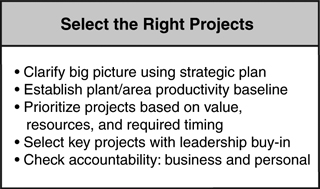
Failure Modes for Selecting the Right Projects
Each of the five steps in leading Six Sigma have associated failure modes. If one understands what the failure modes could be ahead of time, preventing the failure modes from occurring is much easier. Four common failure modes for selecting the right projects would include the following:
• Poorly defined strategy.
• Projects not tied to financial results.
• Poorly defined project scope, metrics, and goals.
• Many projects lasting more than six months.
By assessing the Step 1 actions and the failure modes, ways to improve your ability to select the right projects will be improved. This project selection system will be usable within any follow-on improvement initiative.
Step 2: Select and Train the Right People. Figure 16.2 summarizes this step. Selecting and training the right people is the purpose of Step 2. This step addresses selecting the Six Sigma Champion, Master Black Belts, Black Belts, and Green Belts. The training plan is developed as part of this step, which includes leadership and Belt training. After Figure 16.2, the common failure modes for this step are listed.
Figure 16.2 A summary of the actions associated with Step 2: Selecting and Training the Right People.
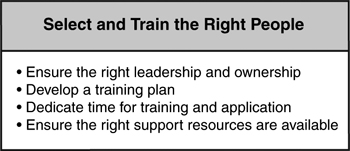
Failure Modes for Selecting and Training the Right People
Four common failure modes for selecting and training the right people are included in the following bulleted list. There are, of course, many more failure modes you will be considering throughout your deployment.
• Wrong people assigned to the projects.
• Leadership doesn’t understand their role.
• No centralized training plan.
• Lack of understanding of Six Sigma resulting in poor support from Finance, IT, HR, Maintenance, and QC Lab.
These failure modes are easily preventable by setting the right actions in the deployment plan.
Step 3: Develop and Implement the Improvement Plans. Figure 16.3 summarizes Step 3 of the leadership roadmap, developing and implementing the improvement plans. This is the muscle of Six Sigma leadership. The projects have been selected, validated, and chartered. The students have been trained in Six Sigma methods and the teams are in place. There are now dedicated Black Belts, Green Belts, and resources.
Figure 16.3 A summary of the actions associated with Step 3: Developing and Implementing Improvement Plans.
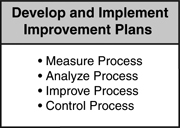
Support resources are at ready alert to provide support to the Six Sigma teams as needed. You even have a network of Master Black Belts floating around mentoring the Black Belts and teams. Your training has been customized to target groups and the projects cover a wide array of applications (Product Development, Administrative, Asset Dependability, Marketing, Sales, Human Resources, and Technology).
Failure Modes for Developing and Implementing Improvement Plans
The action of developing and implementing improvement plans represents the engine of Six Sigma to get things done and to attain the aggressive goals you have set. Six of the common failure modes include the following:
• Belts have little or no time to work on their projects.
• Large project teams and infrequent project meetings.
• Poor support from rest of the organization.
• Insufficient project support, and/or project support from a BB with limited experience.
• Lack of technicians and operators when you need them.
• Focus in on training, not improvement.
These failure modes directly relate to the sense of urgency the organizations within a company have about getting the results from the projects. The other aspect relates to how well the teams are lead, managed, and supported. Six Sigma is not a training game but a serious effort to improve the business. If the first step is done well, and great, believable projects are selected, the teams have a good sense of urgency around each project. Six Sigma projects and teams are integrated directly into the day-to-day operations of any organization.
Step 4: Manage Six Sigma for Excellence. Figure 16.4 shows Step 4, managing Six Sigma for excellence. Step 4 is the key to institutionalizing Six Sigma. The Champions reviewing their projects at least once per week and consistently reaffirming the potential financial impact of the projects from a finance point of view is critical. Each Champion should plan on spending at least 30 minutes per week per Belt. Effective communication of the program and a strong R&R scope will be the grease that keeps the wheels rolling.
Figure 16.4 A summary of the actions associated with Step 4: Managing for Excellence.

Failure Modes for Managing for Excellence
Managing for excellence is critical for the institutionalization of Six Sigma to occur. This step specifically has to do with leadership. Four common failure modes include the following:
• Wrong people assigned to the projects.
• Leadership doesn’t understand their role.
• No centralized training plan.
• Lack of understanding of Six Sigma resulting in poor support from Finance, IT, HR, Maintenance, and QC Lab.
These failure modes can be tracked directly back to a poor deployment. With great preliminary training of the company leadership, everyone will understand the importance of executing Six Sigma. The hallmark of any successful change initiative is getting the right people positioned in the right places. Integrating Six Sigma into the businesses is important to sustain the effective support of the support functions. None of these failure modes are hard to understand, but prevention must be considered in advance. But, the mark of superb leadership is making these difficult things happen.
Step 5: Sustain the Gains. Figure 16.5 shows a summary of Step 5, sustaining the gains. The two hardest things to do in any organization is (1) Start a new process and (2) Stop the old process. That’s why implementing a control system everywhere for every process is so important. There should be a control system for each Black Belt and Green Belt project. The process owner owns the control system. Part of the control system is to maintain a “project hopper,” which is the repository for potential follow-on process improvement project. The control system undergoes regular reviews to verify the effectiveness of the Six Sigma system. Each project is reviewed at six months and one year after completion to ensure that the gains are still occurring. And, finally, the BB, GB, and Champion ranks are constantly refreshed.
Figure 16.5 A summary of the actions associated with Step 5: Sustaining the Gains.
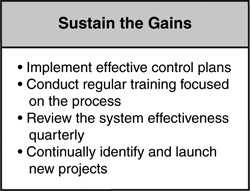
Failure Modes for Sustaining the Gains
Sustaining the gains is a critical step in both attaining and continuing the performance for which you are driving. The most difficult event in problem solving is not actually solving the problem. Rather, it is instituting the new change and making the change last. Six common failure modes include the following:
• No formal control plan system: Inadequate or incomplete project control plans.
• No process performance metrics in place.
• No process audit system in place.
• Control plans not implemented properly.
• Control plans not owned by process owner.
• System assumed to be working; no system reviews in place.
The Step 5 failure modes are oriented toward the lack of a definitive control system. Control systems are common, though I’d say not excellent, in manufacturing operations. In the transactional processes, there is usually little in the way of control systems or the systems are not complete. A combination of performance metrics and process audit systems are necessary to sustain the gains over the long term. Developing a clear method for implementing new control systems is the opportunity represented by Step 5.
Is Your Deployment Effective and Efficient?
The next Six Sigma assessment activity after assessing the leadership aspect of deploying Six Sigma is to assess the effectiveness or efficiency of your original deployment plan or the upcoming deployment plan. There are four stages to any Six Sigma deployment: (1) Plan and Assess; (2) Engage; (3) Execute and Practice; and (4) Internalize. Here is a summary of actions for each step:
• Plan and Assess
• Create strategic alignment.
• Define finance rule set to track results.
• Executive interview process.
• HR decisions.
• Establish project pipeline.
• Engage
• Executive Launch summit.
• Communication plan in place.
• First round of Champion sessions.
• Resource plan for Six Sigma in place.
• Execute and Practice
• Black Belt training launched.
• Lean events activated.
• Project mentoring initiated.
• Green Belt training launched.
• Project execution underway.
• Internalize
• Master Black Belts developed.
• Strategy, HR, and rewards linked to Six Sigma.
• Train-the-trainer has begun.
• Institutionalize project pipeline process.
Is your culture ready to change? You may well ask the question as to whether your culture is ready for change. The following set of questions is useful in assessing the organization’s readiness for change. Respond to these questions on a 1 to 10 scale (1=absolutely no and 10=absolutely yes).
Cultural Readiness to Change Scale
1. Is the organization structure relatively stable; that is, no dramatic changes soon?
2. Will the business leader make Six Sigma a top priority?
3. Does leadership have credibility and a history of successfully implementing company-wide improvement initiatives?
4. Will the business devote 10 percent of its resources to Six Sigma?
5. Will the business leadership team dedicate its top talent to Six Sigma?
6. Will members of the leadership team invest two days of their time to learn how to be credible Six Sigma Leaders?
7. Is the business leadership team open to actively sponsoring Six Sigma projects?
8. Is the organization comfortable working in teams?
9. Are decisions based upon analysis of relevant data at all levels in the organization?
10. Is work defined in terms of processes? Are key processes documented and accountabilities clear?
Based on the total score when summing from item 1 to item 10, a score of 75+ means your culture is probably ready for change. If the total score falls between 50 and 75, there may be some risk. If the total score is below 50, you would want to pay close attention to the culture either before deployment or within a few months after deployment.
Is Everything Aligned to the Strategy?
I’ve talked about alignment throughout this book. Aligning the external realities with the strategy, the financial targets, and the internal actions is the mantra. If your Six Sigma deployment is waning or you think there are risks to success before the deployment, check alignments.
Aligning Six Sigma Projects to Strategy. Chapter 9, “Committing to Project Selection, Prioritization, and Chartering,” covered this topic extensively. Projects should be aligned to goals set around financial targets or operational metrics and then aligned to strategic thrusts. Using goal trees to depict the project, metric (Big Y), and strategic thrusts alignment is extremely visible, simple, and effective. Deploying the use of goal trees is a great method for ensuring proper alignment of projects. The projects should be aligned with the goals of each business in addition to the strategy. Figure 16.6 demonstrates the linkage from the strategic goals of improving working capital to the business goal to a project cluster to project number one. Success in project number one improves working capital for the business and working capital strategically.
Figure 16.6 The linkage among strategic goals, business goals, and projects.

Are You Communicating Effectively? Effective communication within a Six Sigma deployment is essential. It’s not a bad idea to assess your communication of Six Sigma and update your communication plan. The following factors are a great place to start:
• Who needs to be informed?
• What is the message?
• When does the communication need to occur?
• Why does the communication need to take place. . .the outcome?
• Who will inform them?
• What is the media?
• What is the rhythm?
Chapter 12, “Communicating the Six Sigma Program Expectations and Metrics,” covers communication in detail. Review that chapter and then answer these questions, and you will assess (1) If you are ready to deploy or (2) Whether the current plan needs updating. Don’t underestimate the effect of the communications plan on your change and your deployment.
Is the Finance Function Actively Participating? Because Six Sigma is focused on financial performance, the finance function within every business in a company leverages their knowledge, databases, and expertise to the entire Six Sigma process. CFOs are commonly major players in the deployment. The railroad company, CSX, had their CFO champion the entire process. The CFO at Rockwell International is heavily involved because of his positive introduction to Six Sigma while at AlliedSignal. The summary of the Finance roles follow:
• Provide support throughout the Six Sigma projects
• Qualify project opportunities.
• Identify leverage opportunities.
• Validate process measurement proposals.
• Verify projected dollar benefits as goals.
• Characterize area of financial impact.
• Provide ongoing project financial improvement evaluation.
• Substantiate end-of-project savings/benefits
• After project completion.
• Authentication of project financial results.
The financial function is to create and validate financial results. In Table 16.1, an estimate of the financial impact for a business’s Six Sigma project plan is shown. The financial function estimates about a $120,000,000 impact on pretax income. That would be equivalent to starting a $1 billion business with no new capital.
Table 16.1 Forecast of the Financial Impact of Black Belt and Green Belt Projects for a Year

Are You Tracking Your Program’s Progress? Chapter 14, “Defining the Software Infrastructure: Tracking the Program and Projects,” was spent talking about enterprise-wide tracking systems. How are you tracking the progress of your current or future program? Figures 16.7–16.9 show screenshots of a project-tracking system that tracks specific aspects of project work.
Figure 16.7 Project Define-Analyze-Improve-Control workflow.
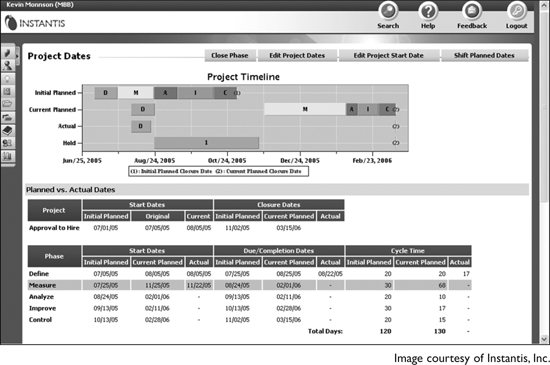
Figure 16.8 Overall project progress.
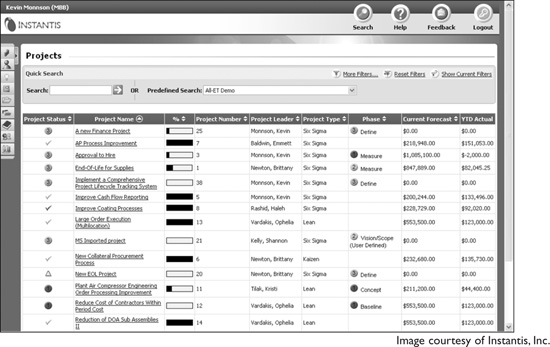
Figure 16.9 Deployment progress.
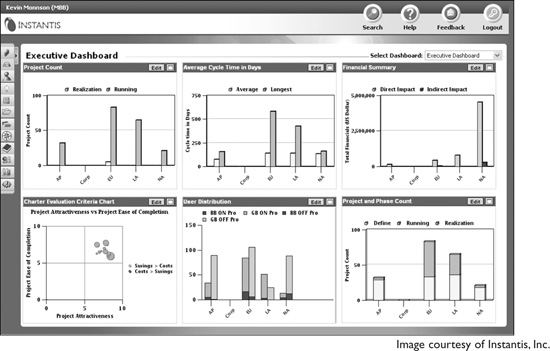
There is a huge amount of benefit by tracking a change initiative across the enterprise from a centralized control point. Company leadership should be able to report the return on investment to the stockholder, Wall Street, employees, and customers. This process should be easy and comprehensive. The system also adds to the discipline the program needs to get institutionalized.
Time to Extend Your Program: Using Deployment Successes to Go Further and Faster
Because Six Sigma is applicable across the enterprise, Six Sigma can be deployed into multiple arenas. There are quite a few ways to extend your Six Sigma program:
• Extend to other functional departments.
• Extend to involve more of your employee population.
• Extend your Six Sigma product lines.
• Extend to your supply chain.
• Extend to involve your customers.
Extend Six Sigma to Other Functional Departments. Any function within any business can benefit from Six Sigma. Anything of value the customer receives from us is an output of a process. Every function executes a set of processes. To be world class, every process must function effectively and be streamlined, efficient, and constantly improved. Any new product or service is the output of a development process. I facilitated a legal department that identified at least 45 processes they executed on a day-to-day basis. The list that follows shows only a small sample of projects for a variety of functions.
• Finance Six Sigma Projects
• Financial Closing Activities, Cycle Time
• Billing System Disconnects
• Write-Offs—A/R, Bad Debts
• Tax Credits—Sales and Use Tax, Recovery of Bad Debts, and so on
• Cash Flow Management
• Days Sales Outstanding
• Price Increase
• Accounts Receivable
• Improve Payment/Collection Processes
• Improve Audit Process Discovering Non-Compliance
• Reduce Electronic Financial Transaction Costs
• Reduce the Cycle Time of Reconciliation
• Decrease Payment Processing Costs to Vendors/Suppliers
• Human Resources and Administrative Six Sigma Projects
• Improved Processs for Transfer Assignments
• Recruitment
• Retention
• Payroll Rejects/Administration
• Sales Rep Turnover
• Workers Comp Reduction
• Union Effectiveness
• Employee Training
• Time and Attendance Efficiency
• Medical/Dental Benefits
• Leave Time Eligibility, Application, and Administration
• Merit Pay Design
• Ex-Pat Repatriation
• Department Audit Process
• Time Card Accuracy
• Proprietary Information Destruction
• Stock Option
• Profit Sharing
• Expense Report Cycle Time
• Paperwork Reduction
• Office Supply Acquisition
• Office Machine Maintenance
• Security Access and Control
• Vacation Tracking and Control
• Recycling
• Drug Testing
• New Acquisition Integration
• IT Six Sigma Projects
• Desktop Support
• Disk Space Management
• Functional Test Environment
• Internet Response Time
• Batch Job Scheduling Defect Reduction
• Reduce Defect Leakage
• Lab Hardware
• ODC Entitlement
• Reduce the Cost and Consumption Cycle Time
• ERP—Migration, Optimization
• Report Elimination
• Computer Hardware/Software Acquisition
• Orphan Data Reduction
• Software License Process and Validity
• Asset Management
• Outsourcing Rationalization
• Application Up Time
• Software Development Life Cycle
• Software Application Risk Management
• Data Warehousing
• Sales and Marketing, Communications, and Legal Six Sigma Projects
• Sales Force Effectiveness
• Sales/Customer Interaction
• Market Forecasting Process
• Sales Projection
• Proposal Creation
• Case Work Effectiveness
• Electronic Payables
• Margin Erosion in Sales Process
• Reduction of Dealer Price Variations
• Improve Timing of Sales Invoices
• Payment Transactions
• Corporate Goal Communication Process
• Public Perception Measurement
• Proprietary Information Control
• Communication-Devised Issuance and Control (Pagers, Beepers, Cells)
• Legal Documentation Efficiency
• Patent Control
• Product Liability
• Mergers Acquisition
• Consultant Contract Review
• Corporate Governance
• Call Center First-Time Resolution
Extend to Involve More of Your Employee Population. Early in most Six Sigma deployments, Six Sigma is applied to limited parts of the company. Many companies apply Six Sigma strictly to manufacturing operations. Therefore, only those folks involved in manufacturing have a chance to get involved with Six Sigma. Because only 3 to 5 percent of the population become Black Belts, that leaves a huge percentage with Six Sigma team membership as the only venue to Six Sigma.
The Green Belt role is a great way to widen participation in Six Sigma. A much larger percentage of the population can be Green Belts. Take a look at the first two years of the GE Six Sigma deployment. At the end of two years, GE had trained 4,000 Black Belts and 60,000 Green Belts, a huge difference in percentage of the total population trained.
When working at AlliedSignal, I had launched a Yellow Belt program, aimed initially at line operators on the manufacturing floor. This ended up being a very popular program, with hundreds of line operators receiving training in the same tools that the Black Belts use.
I also launched a training program for the first-line supervisors, another segment of the population brought to bear on Six Sigma. With a good needs assessment and some imagination, Six Sigma can be tailored to any number of subpopulations within your company. Developing unique applications of Six Sigma to unique populations is a great way to reinvigorate your program in the right way.
Extend to Include Additional Six Sigma Products and Services. The product portfolio for Six Sigma is huge. There will always be training applications that you won’t be using. Taking a good look at your strategic gaps where Six Sigma is missing and plugging those gaps with new Six Sigma methods will maintain the momentum in your Six Sigma program. Chapter 11, “Selecting and Training the Right People,” discusses the wide array of Six Sigma applications. By studying that portfolio and assessing where your impact is occurring, you can design the next phase of your Six Sigma deployment.
Adding Lean Enterprise to the Six Sigma initiative is one way to expand Six Sigma. Many companies start with manufacturing and move Six Sigma to product development and design. Some companies move Six Sigma through the companies in phases, with one emphasis at a time. Other, bolder companies drive Six Sigma in many different areas simultaneously.
Extend Six Sigma to Your Supply Chain. Many suppliers have noticed that when their customers launch Six Sigma, it’s not long before the customers are requiring their suppliers to participate as well. Because suppliers are a major part of the value chain map, it only makes sense—manufacturing speed and quality are driven in large part by the efficiency and quality of their suppliers.
The idea here is that your supply chain management leaders aggressively start a Six Sigma program made available to the supply base. To receive this training, the suppliers must, in cooperation with the host company, commit to their own Six Sigma goals that tie to improving their performance for that particular customer (speed or quality). The hosting company provides the training and mentoring support from their own Master Black Belts and Black Belts. The host company will also provide leadership training for key suppliers. The point is, if your company develops a core competency in Six Sigma, why not provide that competency to key suppliers to optimize the entire value chain.
Align the Supplier Six Sigma program to incorporate corporate goals. . .assess whether the supplier’s vision, customer requirements, critical processes, and improvement activities are parallel to yours. It is best to improve your internal process capability first before extending Six Sigma projects to suppliers. Make sure that all processes to which suppliers will be connected are optimized.
You must lead from the front if you expect your suppliers to take the Six Sigma interface seriously. When at Motorola, I ran a manufacturing line that produced electronic engine controllers with one customer, Ford. At that time (1988), Ford was pushing statistical process control (SPC). While we implemented a great SPC system, it was noted that, when touring Ford’s factories, there was a conspicuous absence of SPC charts. That invalidated their threats around SPC. We simply did it because it was the right thing to do.
When connecting suppliers to your Six Sigma program, you must provide clear, actionable Voice of the Customer (VOC) to suppliers providing inputs to your organization’s processes. If your organization does not know its own processes to a point where those requirements can be clearly communicated, suppliers will be navigating improvement projects without a compass. You will also lose credibility with your suppliers.
Extending Six Sigma to your supply base has a huge potential ROI. And it helps your suppliers become more competitive and willing to invest in improvement, making you look good. Launching a supplier program in Six Sigma will also help you focus on your own program to ensure that your program is the best it can be.
Extend Six Sigma to Your Key Customers. It may seem presumptuous to link your customers into Six Sigma, but it works if you do it right. Once mastered, Six Sigma becomes a great marketing tool. GE Health Care uses Six Sigma services as part of their CAT scan sales and other products. The AlliedSignal experience told us we could effectively market Six Sigma into the customer base. In one case, we moved from being completely de-sourced with one customer to becoming that customer’s sole supplier.
The CEO of the company said it was simply because we could help him deploy Six Sigma. In other AlliedSignal businesses, we were able to get more volume and better prices by using Six Sigma as an additional service. We also got very close to those customers working with us. Our Black Belts worked in their factories and got direct voice of the customer.
As with suppliers, it’s best to develop the Six Sigma core competency before striking out into the customer base. Using Six Sigma as an interface with your customers, you will engage them at a different level, and you will be able to share the benefits of Six Sigma.
• Engage your customers
• Hear their voice
• Create a relationship of trust
• Partner to develop strategic growth plans
• Shared Benefits
• Common language
• Disciplined methodology for solving collective problems
• Data-driven decisions
• Embeds customer-thinking deep within both organizations
Six Sigma Success Factors. To successfully deploy Six Sigma, there are at least nine success factors to pay attention to and to assess when you are reinvigorating your program. The success factors are as follows:
1. Deployment plan—Chapter 3
2. Senior leadership training—Chapter 10
3. Strategic projects—Chapter 9
4. Development of technical experts—Chapter 11
5. Resources available and motivated—Chapter 13
6. Training and training plan—Chapter 11
7. Communications—Chapter 12
8. Project reviews—Chapter 9
9. Project tracking—Chapter 14
By reviewing the associated chapters in this book and identifying the gaps in your deployment, you can accelerate the rate of institutionalization of Six Sigma.
Assessing Your Program Using Kotter’s Eight Stages
As discussed in Chapter 3, “Six Sigma Launch Philosophy,” the Harvard professor, John Kotter, has delivered a very workable and straightforward model for change. I will list his recommended steps with common failure modes seen in Six Sigma deployments, as follows:
1. Establishing a Sense of Urgency
a. Failure modes:
i. No sense of urgency created—no accountability.
ii. Absence of senior leadership.
iii. No commitment of leadership to understand change.
iv. Complacency rules the day.
2. Creating a Guiding Coalition
a. Failure modes:
i. Champions have poor positional power.
ii. No formal coalition established.
iii. Poor commitment to up-front workshops and training.
iv. No clear accountability for results.
v. Guiding deployment with weak steering teams.
vi. Not weeding out people against the change.
3. Developing a Vision and Strategy
a. Failure modes:
i. No vision developed—program is a training program.
ii. Vision not linked to strategy.
iii. No sense of urgency to support the vision.
iv. Six Sigma not linked to strong results.
v. Doing Six Sigma to check a box.
4. Communicating the Change Vision
a. Failure modes:
i. No communication plan—Six Sigma becomes a stealth program.
ii. Communicated at upper levels but not at the lower levels.
iii. Leadership not visible in their commitment and communication.
iv. Under communicating.
5. Empowering Employees for Broad-Based Action
a. Failure modes:
i. No leadership commitment to intense workshops and training.
ii. Little involvement in project selection.
iii. No project tracking.
iv. Six Sigma viewed as a nice training program.
v. Little onsite project support given.
6. Generating Short-Term Wins
a. Failure modes:
i. No accountability established.
ii. More than 12 months to achieve reasonable results.
iii. No formal recognition ceremonies with clear presence of senior leadership.
iv. No clear financial support to establish business impact.
v. Launching too many projects at once.
vi. Providing the first win too slowly.
7. Consolidating Gains and Producing More Change
a. Failure modes:
i. Program stagnates.
ii. Internal experts not developed.
iii. Program results not carefully tracked via metrics.
iv. Six Sigma projects seen as extra work that detracts from day-to-day operations.
v. Convincing the organization that they’re done when they’re not.
8. Anchoring New Approaches in the Culture
a. Failure modes:
i. Business as usual—if Six Sigma disappeared, no one would notice.
ii. Promotions not linked to Six Sigma activities.
iii. No development of MBB internal resources to support program.
iv. Few changes in systems and leadership style from one wave of BBs to the next.
v. Students consistently show up at training with poorly defined, small projects.
By reviewing Kotter’s eight stages as an assessment, you will be able to quickly find holes in your Six Sigma deployment plan or your Six Sigma launch. Developing a core competency around Kotter’s eight stages means you have set the stage for other change initiatives.
Six Sigma: The Initiative
Six Sigma has been one of the most successful change initiatives in decades mostly because it works. Understanding the deployment of change initiatives and driving one initiative to a successful conclusion is a valuable service to the future of any company. Larry Bossidy, in his book, Confronting Reality, gives four aspects of leading initiatives:
• Intense focus
• Hard work
• Tremendous time
• Endless physical and emotional energy
These are the behaviors that senior leadership exhibits in successful initiatives. But, nothing beats a great deployment plan based on preventing the common failure modes. The plan, after all, has to reach all levels of your company and motivate everyone to work as hard as you do to reach success. As a leader, you have to honestly answer these questions to plan your deployment.
• Do you know the initiative well enough to develop metrics to assess success?
• Are you willing to commit the resources to education?
• Do you have the focus and discipline?
• Do you have the stamina?
• Do you have the courage to confront those who stand in the way?
I went to school at Southwest Texas State University. SWT’s most well-known alumnus was Lyndon B. Johnson, former President of the United States. After Lyndon retired from the Presidency, he honored our Student Senate at SWT by sitting in on one of our meetings. This was the meeting where a friendly coalition and I tried to pass a bill to eliminate the school football team and use the resulting financial savings for student sports. Considering the status that football has in Texas, needless to say I had to lay low for a while. Well, our bill lost, and that was that.
Lyndon made some summary remarks that went about like this. “I’ve been watching y’all try to do politics. You’re not very good at it. Leading in the political theater is basic. First, you decide whether what you want to accomplish is right. If you decide it’s right, then (the words of wisdom) you run over anyone that gets in your way!”
That’s not the most humanistic approach for sure, but LBJ accomplished an amazing amount of change during his political career. That includes bringing electricity to rural Texas by teaming up with rival Republicans. His comment has always stuck with me. When I decided that what I wanted to do was the right thing to do, I heeded his advice and knocked over every barrier that blocked the way.
When launching Six Sigma, you first have to believe it’s the right thing for the company’s future. Once you decide Six Sigma is the right thing, then follow good form (Kotter’s eight stages) and learn from those who came before you. A successful Six Sigma launch will have a positive impact on all your people and will be the one event in your career that you will remember fondly. Good luck, and I’ll see you on the road to Six Sigma!
